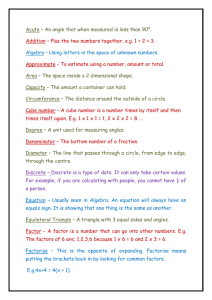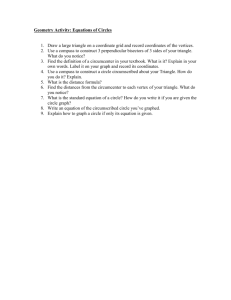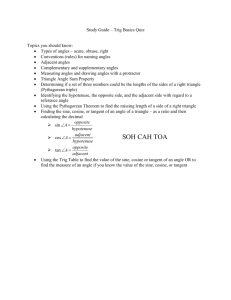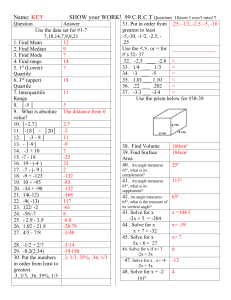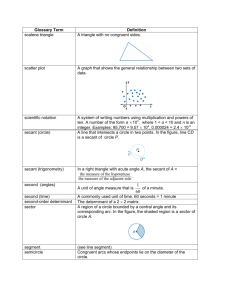13.2 – Angles and the Unit Circle
advertisement
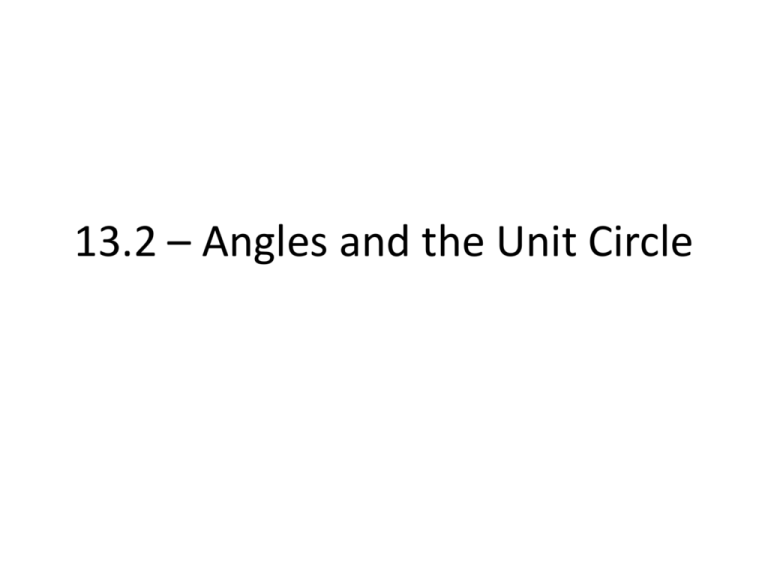
13.2 – Angles and the Unit Circle Angles and the Unit Circle For each measure, draw an angle with its vertex at the origin of the coordinate plane. Use the positive x-axis as one ray of the angle. 1. 90° 2. 45° 3. 30° 4. 150° 5. 135° 6. 120° Angles and the Unit Circle For each measure, draw an angle with its vertex at the origin of the coordinate plane. Use the positive x-axis as one ray of the angle. 1. 90° 2. 45° 3. 30° 4. 150° 5. 135° 6. 120° 1. 2. 3. 4. 5. 6. Solutions The Unit Circle The Unit Circle - Radius is always one unit - Center is always at the origin - Points on the unit circle relate to the periodic function Let’s pick a point on the unit circle. The positive angle always goes counter-clockwise from the x-axis. 1 30 -1 1 -1 The x-coordinate of this has a value of the cosine of the angle. The y-coordinate has a value of the sine of the angle. In order to determine the sine and cosine we need a right triangle. The Unit Circle The angle can also be negative. If the angle is negative, it is drawn clockwise from the x axis. 1 -1 - 45 -1 1 Angles and the Unit Circle Find the measure of the angle. The angle measures 60° more than a right angle of 90°. Since 90 + 60 = 150, the measure of the angle is 150°. Angles and the Unit Circle Sketch each angle in standard position. a. 48° b. 310° c. –170° Let’s Try Some Draw each angle of the unit circle. a. 45o b. -280 o c. -560 o The Unit Circle Definition: A circle centered at the origin with a radius of exactly one unit. (0, 1) (-1,0) |-------1-------| (0 , 0) (1,0) (0, -1) What are the angle measurements of each of the four angles we just found? 90° π/2 0° 0 360° 2π 180° π 270° 3π/2 The Unit Circle Let’s look at an example The x-coordinate of this has a value of the cosine of the angle. The y-coordinate has a value of the sine of the angle. 1 In order to determine the sine and cosine we need a right triangle. 30 -1 1 -1 The Unit Circle 1 30 -1 1 Create a right triangle, using the following rules: 1. The radius of the circle is the hypotenuse. 2. One leg of the triangle MUST be on the x axis. 3. The second leg is parallel to the y axis. Remember the ratios of a 30-60-90 triangle2 -1 30 60 1 The Unit Circle 1 2 60 30 P X- coordinate 30 -1 1 Y- coordinate -1 1 Angles and the Unit Circle Find the cosine and sine of 135°. From the figure, the x-coordinate of point A is – 2 , so cos 135° = – 2 2 , or about –0.71. 2 Use a 45°-45°-90° triangle to find sin 135°. opposite leg = adjacent leg = 2 2 0.71 Substitute. Simplify. The coordinates of the point at which the terminal side of a 135° angle intersects are about (–0.71, 0.71), so cos 13 –0.71 and sin 135° 0.71. Angles and the Unit Circle Find the exact values of cos (–150°) and sin (–150°). Step 1: Sketch an angle of –150° in standard position. Sketch a unit circle. x-coordinate = cos (–150°) y-coordinate = sin (–150°) Step 2: Sketch a right triangle. Place the hypotenuse on the terminal side of the angle. Place one leg on the x-axis. (The other leg will be parallel to the y-axis.) Angles and the Unit Circle (continued) The triangle contains angles of 30°, 60°, and 90°. Step 3: Find the length of each side of the triangle. hypotenuse = 1 1 2 shorter leg = longer leg = The hypotenuse is a radius of the unit circle. 1 2 The shorter leg is half the hypotenuse. 3= 3 2 The longer leg is 3 times the shorter leg. Since the point lies in Quadrant III, both coordinates are negative. The longer leg lies along the x-axis, so cos (–150°) = – 3 2 , and sin (–150°) = – 1 . 2 Let’s Try Some Draw each Unit Circle. Then find the cosine and sine of each angle. a. 45o b. 120o 45° Reference Angles - Coordinates Remember that the unit circle is overlayed on a coordinate plane (that’s how we got the original coordinates for the 90°, 180°, etc.) Use the side lengths we labeled on the QI triangle to determine coordinates. ( 2, 2 ) 2 2 2 3π/4 135° 2 ) 2 ( , 2 45° π/4 2 2 2 2 5π/4 225° ( 2 , 2 ) 2 2 7π/4 315° ( 2 , 2 2) 2 30-60-90 Green Triangle Holding the triangle with the single fold down and double fold to the left, label each side on the triangle. Unfold the triangle (so it looks like a butterfly) and glue it to the white circle with the triangle you just labeled in quadrant I, on top of the blue butterfly. 60° Reference Angles - Coordinates Use the side lengths we labeled on the QI triangle to determine coordinates. 2π/3 π/3 60° 120° 1 ( , 3 ) 2 2 1 ( 2 3 ) 2 , 3 2 1 2 5π/3 4π/3 ( 1 , 3) 2 2 240° 300° ( 1 2 , 3) 2 30-60-90 Yellow Triangle Holding the triangle with the single fold down and double fold to the left, label each side on the triangle. Unfold the triangle (so it looks like a butterfly) and glue it to the white circle with the triangle you just labeled in quadrant I, on top of the green butterfly. 30° Reference Angles We know that the quadrant one angle formed by the triangle is 30°. That means each other triangle is showing a reference angle of 30°. What about in radians? Label the remaining three angles. 150° π/6 30° 5π/6 210° 7π/6 11π/6 330° 30° Reference Angles - Coordinates Use the side lengths we labeled on the QI triangle to determine coordinates. 3 ( , 2 1 ( 3, ) 2 2 150° 5π/6 1 ) 2 30° π/6 1 2 3 2 7π/6 210° ( 3 , 1 ) 2 2 330° 11π/6 ( 3 ,1 ) 2 2 Final Product The Unit Circle


